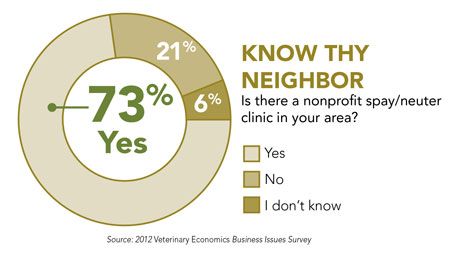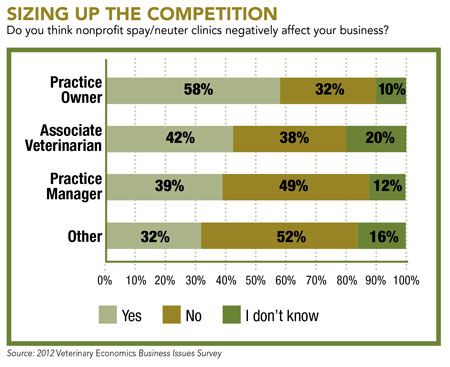Keeping your veterinary hospital profitable in a low-cost culture
Whether you like it or not, spay-neuter clinics are here to stay. But just how much do they really impact the livelihood of your practice? And what can you do to keep your profits up when a low-cost clinic moves into your neighborhood? Find out what our experts had to say.
Next >
Spay-neuter clinics: Three simple words that can spark a debate—or at least a lively conversation—among most veterinarians and industry insiders. Good or bad, everyone seems to have an opinion about them. And according to our 2012 Veterinary Economics Business Issues Survey, it’s a topic that veterinarians and their staff aren’t shy about addressing.
Of survey respondents, more than 50 percent of practice owners reported that nonprofit spay-neuter clinics negatively affect their business, and about 40 percent of associate veterinarians shared the same opinion. To better understand the situation, we turned the results over to our Veterinary Economics experts for their advice on keeping profits up in spite of competition from low-cost clinics.

According to Bob Levoy, a Veterinary Economics Editorial Advisory Board member, veterinarians have to address the realities of today’s market. “A contributing factor to some client defections to low-cost spay-neuter clinics is the fact that many pet owners view spays, neuters, and vaccinations as commodities, regardless of where these procedures are done or who does them, leaving cost or convenience as the deciding factors in choosing a veterinary facility,” he says.
His solution? Resist knocking those nonprofit, low-cost spay-neuter clinics with an apples-and-oranges argument. “Client education is the answer,” he says. “It’s better to acknowledge that your fees are higher. Let your clients observe a surgery on closed circuit TV or give them an itemized bill of the services you performed. This will help put fees into proper perspective.”

Dr. Karl Salzsieder, JD, another Veterinary Economics Editorial Advisory Board member and owner of Salzsieder Consulting and Legal Services in Longview, Wash., sees a direct correlation between the perceived threat of spay-neuter clinics and the type of services a veterinary practice offers.
“For decades, spay-neuter clinics have been a threat to veterinary practices that have tried to use those procedures for covering overhead,” Dr. Salzsieder says. “Veterinary practices must continue to realize that spays, neuters, and vaccines are ‘shopper items’ that must be done with the intent of not losing money.”
If a veterinary practice can’t meet or beat the prices of a nearby low-cost clinic, Dr. Salzsieder suggests packaging spay or neuter surgeries into a 12-month wellness plan that also includes vaccines and examinations. Not only does this guarantee the practice consistent monthly income from the get-go, but if the clients renew their wellness plan—and more than 80 percent of clients do—then the practice would offset the first year’s high costs of surgeries and vaccines with the monthly income they’d receive for years to come.
